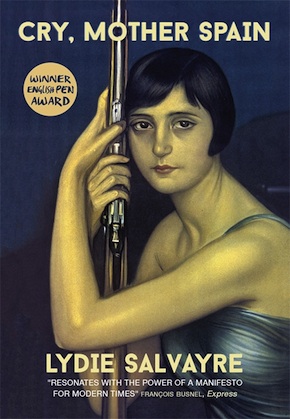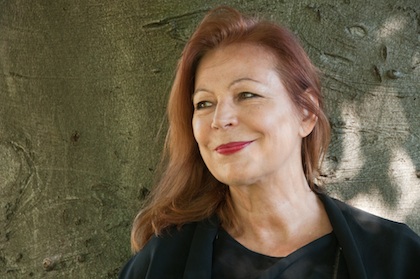Thirteen ways of looking at Guernica
by Mika Provata-Carlone
“Lydie Salvayre creates a dynamic harmony in a language that elevates grit, heroism and beauty.” Le Monde
In the 1930s, the Spanish Reds are promising paraisos to their new recruits. A world freed from class distinctions, slave labour, poverty and squalor, and especially a world liberated from religion – that celebrated ‘opium of the people’. At the same time, those sceptical of Soviet ideology, or vehemently opposed to it, seek to deflect any assault by the liberal or the iconoclastically minded against their own sense of paradise, the structures, institutions, rules of order or domination they hold dear. Both sides, Lydie Salvayre will concede in her romantic ethno-fiction Cry, Mother Spain, have their larger or smaller entitlement to right, both share massive quotas of infamy and guilt, as much collective as individual, about the atrocities, horror, inhumanity and carnage that was the Spanish Civil War.
The numbers fluctuate depending on the source, as Spain is still coming to terms with the ultimate cost of that period of its history, but about half a million dead is the general estimate of the human toll alone – Anthony Beevor tallies the victims of white terror to 200,000, of red terror to 38,000; Julius Ruíz is somewhat more conservative with the first number, which he puts down to 150,000 murdered by the rebels (including 50,000 during the first years of the new regime after Franco’s victory), and a very precise 37,843 assassinated by the Reds. To that one must add ‘collateral damage’, any so-called unavoidable human deaths. Fervently dreamy, beautiful and mesmerising poets disappeared overnight, journalists and soulfully enthusiastic foreign volunteers were blown to unidentifiable smithereens, priests were disembowelled, shot in the back, decapitated, hacked beyond recognition, as were inspired ideologists, loyal and dutiful soldiers, simple people, peasants, urbanites, mothers, fathers, young people, the elderly and children, rich and poor alike. Fields burned, cities crumbled, animals, as they died, howled their agony and bewilderment in the face of human bestiality and viciousness, like Picasso’s monumental, all-too-human horse, painted just as the plumes of smoke and the stench of dying were blowing away from the site of the city which by its tragedy became immortal in one of the finest paintings dealing with our own humanity – or the lack of it.
Cry, Mother Spain is a hard, pugnacious depiction of the dire, utterly deplorable conditions in rural Spain, of the dominant political oppression and of the suppression of local voices, cultures, customs and ways of existence.”
“Spain in 1936 was brimming with insulted people,” we are told early on in this ambitious, multilayered and unnerving narrative about a country falling apart just as it strives to find coherence, identity, strength and a future; about a family whose personal perspective becomes the anchor and catalyst of emotions, causes and historical events; about a French Catholic writer of monarchist sympathies who will find himself torn, emotionally eviscerated, mentally and morally blasted by the violent contrast between what he would have liked to have seen and what he actually witnesses with his own unflinchingly clear eyes. Spain, of course, had seen all this before, barely a hundred years earlier. Francisco Goya’s series of prints, known today as Los desastres de la guerra (Goya’s own title was ‘Fatal consequences of the bloody war with Bonaparte in Spain and other emphatic caprices’) could have been line drawings by eye witnesses of Franco’s path to power, of the resistance to that perfectly organised, bloody and deadly typhoon, with minor sartorial and other decorative alterations.
Cry, Mother Spain is a hard, pugnacious depiction of the dire, utterly deplorable conditions in rural Spain, of the dominant political oppression and of the suppression of local voices, cultures, customs and ways of existence. At the same time it tries to tell a very simple human story of pathos, youthful daydreaming and elation, hope, illusion and disillusionment, of nostalgic reminiscences abstracted from their much more guttural reality so that they can sustain exile, despair, pain and old age. In a landscape of memory and history where the background is complete chaos, where “The only moving thing / Was the eye of the blackbird”, Salvayre seeks to recreate the multiple perspectives that contradictorily yet inevitably define the time of the Spanish Civil War but also, and especially, perhaps, its outcome and the moment after.
Salvayre’s strength is her juxtaposition of a personal, semi-autobiographical narrative with historical research and analysis, ethnographical observation and annalistic discourse, in a visceral, passionate whole. Journalistic facts, historical reports, fiction, and movingly precious though warped and decaying memory, fuse into a single voice that engages ambitiously and originally with the testimony (now merely an echo, according to Salvayre) of Georges Bernanos, the monarchist Catholic writer whose Les Grands Cimetières sous la lune, written in 1938, provide Cry, Mother Spain with its backbone and impetus.
The choice of Bernanos as a companion of the mind, as the ideologically and experientially other, is ingenious, and Salvayre is acute to the powerful resonance of that testament. Bernanos’ account is a unique complement to such shattering chronicles as Orwell’s fearless Homage to Catalonia (1938), Hemingway’s more elaborately dramatic and tragic For Whom the Bell Tolls (1940), Gamel Woolsey’s Death’s Other Kingdom (1938), Gerald Brenan’s popular Spanish Labyrinth (1943), Laurie Lee’s belated A Moment of War (1991) or Franz Borkenau’s stark Spanish Cockpit (1937), which held Orwell’s own admiration. Les Grands Cimetières sous la lune is an unswerving tribute to those who would be left without a voice or a right to memory for almost forty years, as well as a caustic critique of what Bernanos himself held sacred and vital: the Christianity that far from being proven wrong or criminal, had been exposed as a failed, twisted misnomer in its Spanish version of the time.
Salvayre toys eloquently and agilely with emotional, cultural, historical and existential ventriloquism, also with Bernanos’ own prose, poignantly conjuring up the coexistent horror and enchantment.”
Cry, Mother Spain seeks to make subversive use of such contrasting points of view and interpretational perspectives, also of historical moments and voices. It tries to give tangibility, flesh and blood to what Miguel de Unamuno denounced as the lack of reason and argument in every fascist utterance and action. It also strives, not always successfully, not to ignore the necessary balance of vision between red and white myths of supremacy, and deliria of purity, ambition and self-justification. The unifying conception of characters is sometimes forced, lacking naturalness, and Salvayre’s style, which aims to be simple and intense at the same time in order to convey authenticity, contemporaneity, immediacy, comes through on occasion as too intense, too pat or rhetorically ironic. One would have perhaps wished for greater differentiation of emphasis between types of experience or moments of being, and that her psychological portraits were less tightly prescribed, over-determined or all-encompassing. There are also some infelicities in the translation, which seems at times uncertain as regards its idiom and vernacular, yet this is a novel which will not allow the reader to ignore either the timbre of its voice or the explosive urgency of its human content.
Salvayre toys eloquently and agilely with emotional, cultural, historical and existential ventriloquism, also with Bernanos’ own prose, poignantly conjuring up the coexistent horror and enchantment, contrasting, uniting and swapping perspectives in the narratives of Montse, Bernanos, and the generation that cannot but must remember. She achieves a solidarity against evil between the irreconcilable elements that constituted Spain’s reality at the time, even if at the occasional price of facile stereotype conclusions or a historic cynicism that undermines her own genuine sense of tragedy, of right and wrong.
When Salvayre makes us see things through what John Dos Passos called “the camera eye”, she is superb in her empathy, realistic imagery, newsreel quality. Her narrative is passionate and unflinching in such moments, resonant with the stifled humanity she seeks to protect and resurrect. If at times she is highly emotional and blindly protective of loyalties that are hard to define or clarify, that does not reduce the value of this ode to Spain and its dirge about the Civil War. Salvayre presents us with visions both warped and idealised, twisted and bigoted as well as idolised, with the real confusion of aims, morals, ethics, that possessed almost everyone involved, and with the inevitable fanaticism or devastating disillusionment that followed. She then proceeds to wipe away, straighten and expose misunderstandings, miscommunications and misguided principles that resulted in nemesis and slaughter. The French title, Pas Pleurer [one must not cry], is perhaps more intrinsically revealing of her aim than its English counterpart: it comes, she has said, from a letter by the Russian poet Marina Tsvetaeva, an exhortation “not to assume the pose of a tearful victim in the face of adversity”. This, Salvayre certainly achieves, and Cry, Mother Spain is both a release from unspeakable pain and a staunch confrontation with its magnitude and consequences.
 Lydie Salvayre is a former psychiatrist who grew up near Toulouse after her exiled republican parents fled Franco’s regime. As a child she spoke Spanish, only learning French after starting school. Her novel La Compagnie des spectres won the Prix Novembre in 1997 and was named Book of the Year by Lire. Pas Pleurer won the Prix Goncourt in 2014 and the English PEN award in 2015, and is now published as Cry, Mother Spain by MacLehose Press, translated by Ben Faccini. Read more.
Lydie Salvayre is a former psychiatrist who grew up near Toulouse after her exiled republican parents fled Franco’s regime. As a child she spoke Spanish, only learning French after starting school. Her novel La Compagnie des spectres won the Prix Novembre in 1997 and was named Book of the Year by Lire. Pas Pleurer won the Prix Goncourt in 2014 and the English PEN award in 2015, and is now published as Cry, Mother Spain by MacLehose Press, translated by Ben Faccini. Read more.
Author portrait © Martine Heissat
Ben Faccini is a novelist, writer and translator born in England and brought up in rural France and Italy. He worked for many years at UNESCO in Paris and has written extensively on issues in the developing world.
Mika Provata-Carlone is an independent scholar, translator, editor and illustrator, and a contributing editor to Bookanista. She has a doctorate from Princeton University and lives and works in London.

